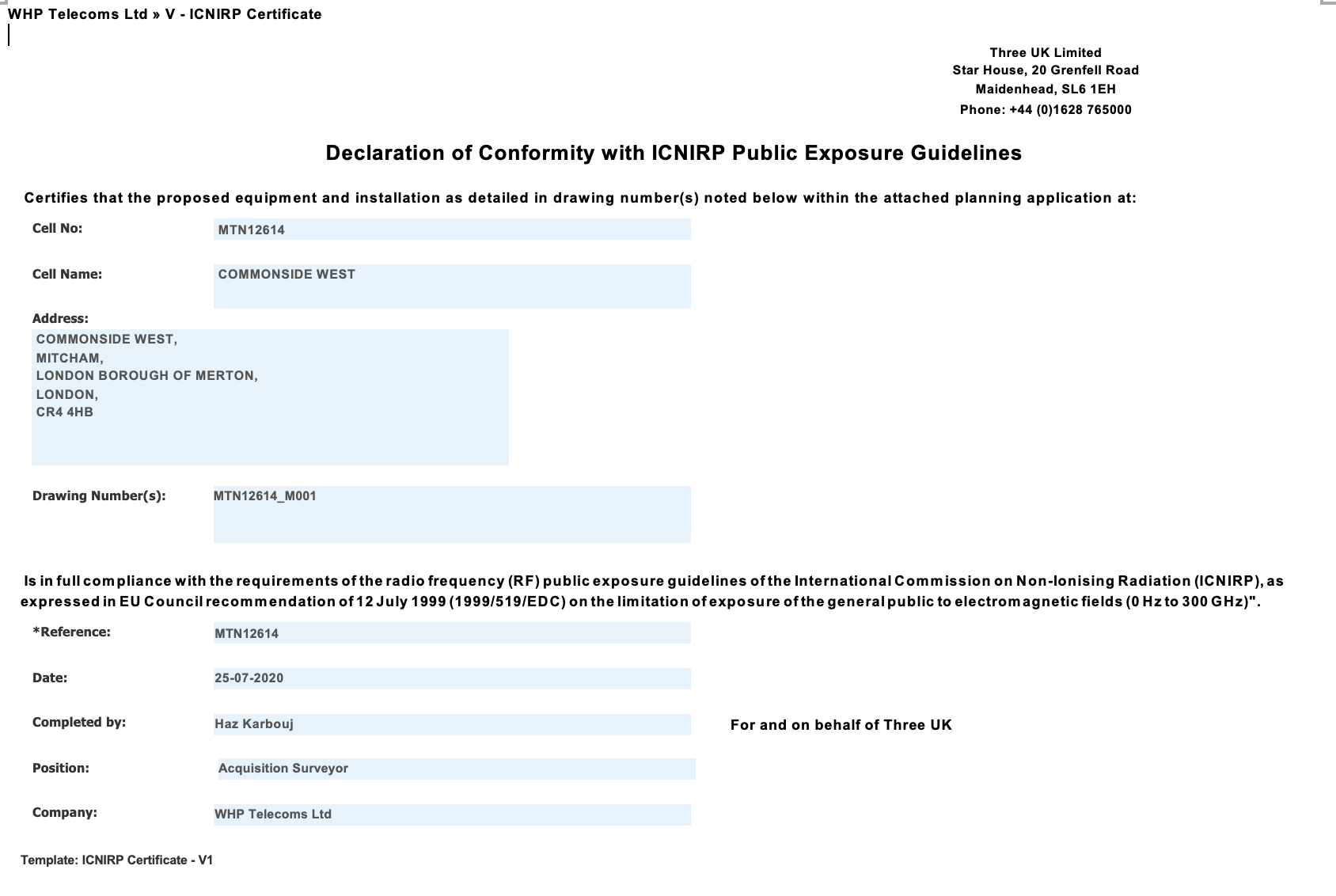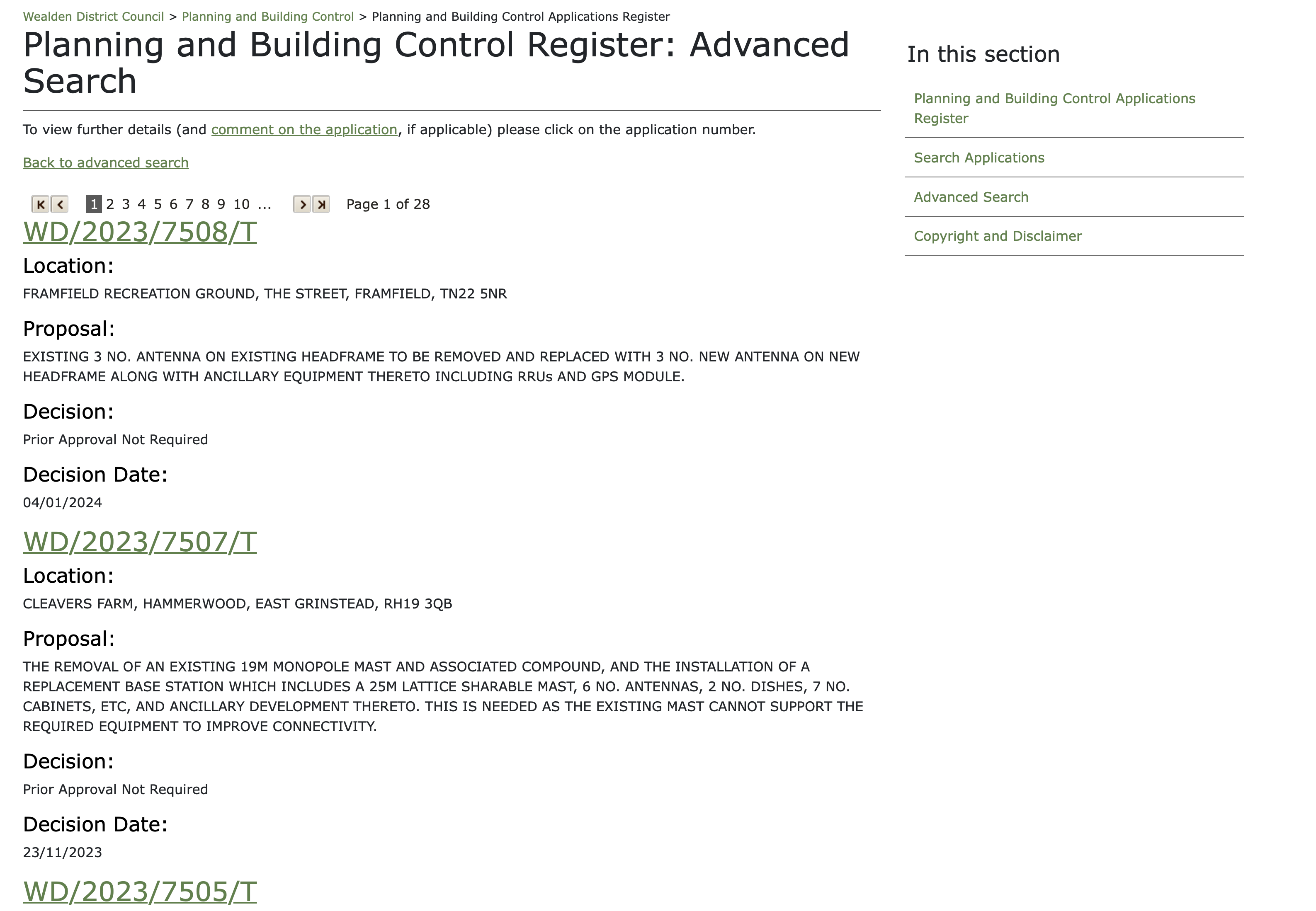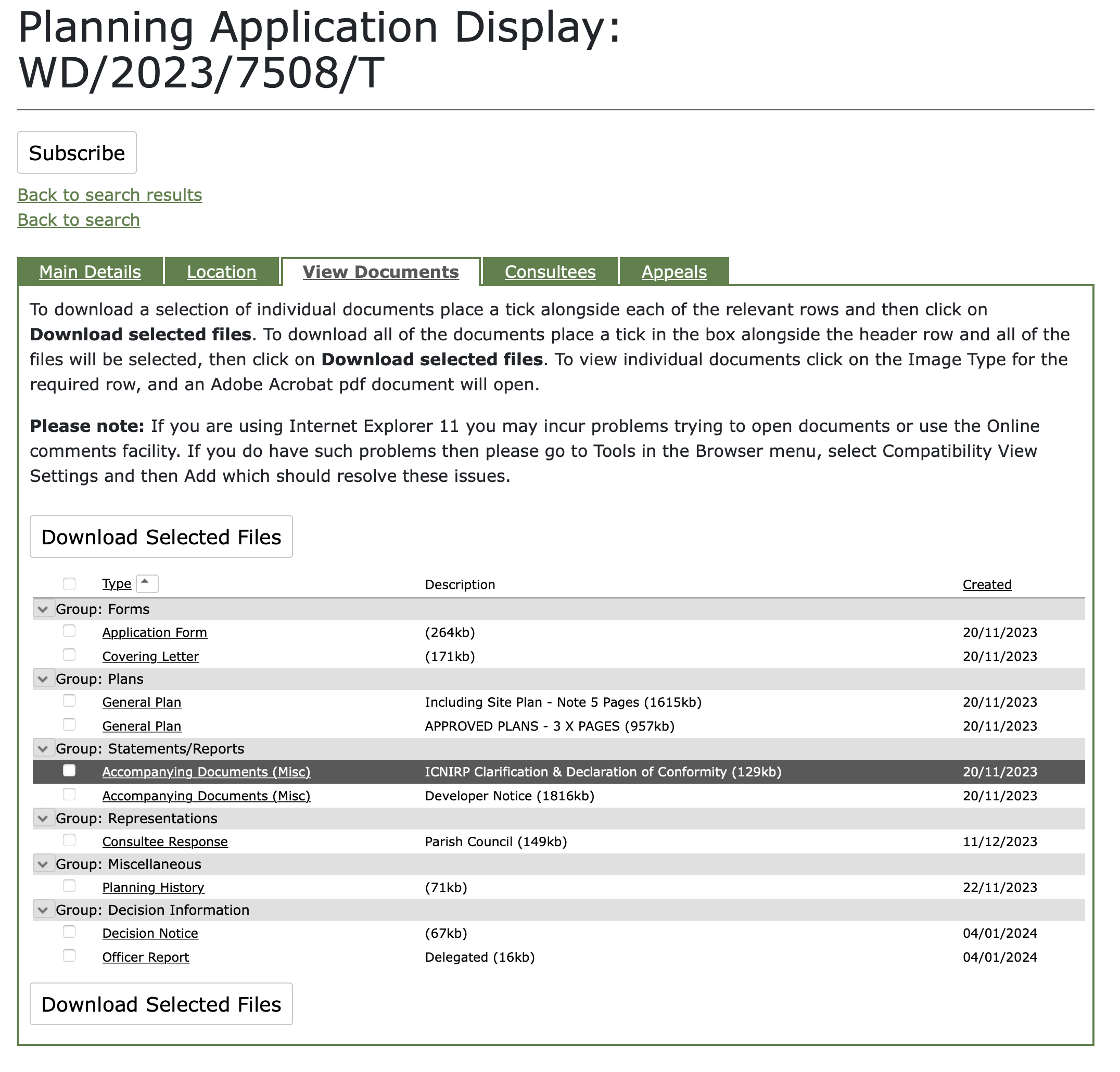Recap: as a campaign our concerns about 5G and the other ‘G’s, including WiFi, are the effects of chronic exposure to pulse modulated and polarised man made signals. The newer phased array signals may add further effects as well. It is established that there are non thermal biological effects from non ionising RF radiation. (Government maintains that there are only thermal effects arising from high power exposure)
Over the years there has been alot of confusion about what 5G technology actually is. Telco applicants, Planners, Campaigners are often ‘at sea’ regarding the specifics. Here are some answers on the tech as a refresher course for 2024:
1) ARE THE 868MHz FREQUENCY SENSORS/EMITTERS IN LED LIGHTS THE SAME AS ‘5G SMALL CELLS’?
No, the 868 MHz frequency sensors/emitters used in LED lights are not the same as 5G small cells. These are two different technologies serving different purposes.
868 MHz Sensors/Emitters in LED Lights:
- Purpose: The 868 MHz frequency is commonly used for short-range, low-power communication, particularly in IoT (Internet of Things) applications. In LED lights, this frequency might be used for wireless control, communication between smart lighting systems, or for energy-efficient sensor networks.
- Technology: This band is often associated with technologies like LoRa (Long Range) or other proprietary low-power communication protocols. These are designed to operate over limited distances and require minimal power, ideal for applications like smart homes, automation, and environmental sensing.
5G Small Cells:
- Purpose: 5G small cells are used to provide cellular coverage and capacity in specific areas, particularly in densely populated urban environments or inside buildings. They are part of the 5G network infrastructure and help enhance network performance by increasing data throughput and reducing latency in localized areas.
- Technology: Small cells use licensed 5G frequencies, which are typically in the Sub-6 GHz (e.g., 3.5 GHz) or mmWave (e.g., 24 GHz and above) bands. These frequencies are much higher than 868 MHz and are specifically allocated for cellular communication to deliver high-speed internet, low latency, and other advanced 5G features.
Key Differences:
- Frequency Band: 868 MHz is a lower, unlicensed band used for short-range communication, while 5G small cells operate in higher, licensed frequency bands allocated for mobile communication.
- Functionality: 868 MHz emitters in LED lights are for local communication and control, whereas 5G small cells are for enhancing mobile network coverage and performance.
- Technology: The technologies and protocols used in these two applications are entirely different, with 5G small cells being part of the broader cellular network infrastructure, and 868 MHz emitters being part of localized, often proprietary communication systems.
2) ARE CERTAIN FREQUENCIES ASSIGNED TO 5G NETWORKS AND OTHER FREQUENCIES NOT SO ALLOCATED?
Yes, specific frequencies are allocated to 5G networks, and other frequencies are reserved for different uses. The allocation of frequencies is managed by national and international regulatory bodies, such as the International Telecommunication Union (ITU) and local regulators like the Federal Communications Commission (FCC) in the United States or Ofcom in the UK.
Frequency Allocation for 5G Networks
5G networks operate primarily within three frequency ranges, which are divided into:
- Low-Band Spectrum (Sub-1 GHz)
- Frequencies: Generally below 1 GHz (e.g., 600 MHz, 700 MHz).
- Purpose: Provides wide coverage and good penetration through buildings and obstacles but offers lower data speeds compared to higher frequencies.
- Mid-Band Spectrum (1 GHz to 6 GHz)
- Frequencies: Commonly around 2.5 GHz, 3.5 GHz, and 4.9 GHz.
- Purpose: Balances coverage, capacity, and speed, making it a core component of many 5G deployments.
- Use Cases: Urban and suburban areas where both coverage and higher data speeds are needed.
- High-Band Spectrum (Millimeter Wave or mmWave)
- Frequencies: Typically 24 GHz and above, including 28 GHz, 39 GHz, and up to around 100 GHz.
- Purpose: Offers extremely high data speeds and capacity but with limited coverage and poor penetration through obstacles.
- Purpose: Offers extremely high data speeds and capacity but with limited coverage and poor penetration through obstacles.
- Use Cases: Dense urban areas, stadiums, and other high-traffic locations where high capacity is needed.
Non-5G Allocated Frequencies
Frequencies not allocated to 5G are reserved for other purposes, including:
- Legacy Cellular Networks:
- 2G, 3G, and 4G networks use various frequencies that are often distinct from those assigned to 5G.
- Wi-Fi and Unlicensed Bands:
- Frequencies like 2.4 GHz and 5 GHz are commonly used for Wi-Fi and other unlicensed wireless communication technologies.
- Industrial, Scientific, and Medical (ISM) Bands:
- Bands like 868 MHz (in Europe) and 915 MHz (in the US) are allocated for non-commercial, low-power uses such as industrial control systems, IoT devices, and other short-range communication technologies.
- Broadcasting:
- Frequencies like the UHF band (470–700 MHz) are allocated for television broadcasting.
- Satellite Communication:
- Specific bands, such as the C-band (4–8 GHz), Ku-band (12–18 GHz), and Ka-band (26.5–40 GHz), are allocated for satellite communication.
Key Points
- Regulated Allocation: Regulatory bodies assign specific frequency bands to 5G to avoid interference with other services and ensure efficient spectrum usage.
- Global Variation: While there is international coordination, the specific frequencies allocated for 5G can vary by country depending on local regulations and existing spectrum use.
- Exclusive and Shared Use: Some 5G frequencies are exclusively allocated to 5G networks, while others may be shared with other services under certain conditions.
The careful management of frequency allocation ensures that 5G networks can coexist with other technologies and services without causing interference.
3 ) IS 868MHZ A 5G FREQUENCY?
No, 868 MHz is not a 5G frequency. The 868 MHz band is primarily used for short-range, low-power communication technologies such as LoRa (Long Range) and other Industrial, Scientific, and Medical (ISM) band applications in Europe. It is commonly used for IoT (Internet of Things) devices, smart meters, and other wireless sensor networks.
5G frequencies, on the other hand, are defined by 3GPP and typically fall into two main categories:
Sub-6 GHz bands: These are frequencies below 6 GHz, including:
Low-band spectrum (e.g., 600 MHz, 700 MHz)
Mid-band spectrum (e.g., 3.5 GHz)
Millimeter-wave (mmWave) bands: These are frequencies above 24 GHz, including:
24 GHz, 28 GHz, 39 GHz, and higher bands (up to around 100 GHz)
These bands are used to achieve different 5G performance characteristics, such as broad coverage and high data rates. However, 868 MHz is not included in the frequencies allocated for 5G networks.
A 5G protocol in 3GPP (3rd Generation Partnership Project) is defined by a set of standards and specifications that outline the architecture, functionalities, and procedures for 5G networks. These protocols ensure interoperability and consistent performance across different equipment and networks. Key elements that define a 5G protocol in 3GPP include:
- Radio Access Network (RAN) Specifications:
- New Radio (NR): 5G uses NR as its air interface, which includes specifications for frequency bands, carrier aggregation, beamforming, and more.
- Dual Connectivity: Allows devices to connect to both LTE and NR simultaneously, ensuring seamless transitions and improved data rates.
- Core Network (CN) Specifications:
- 5G Core (5GC): A new core network architecture that supports the 5G system, providing a more flexible and service-based architecture compared to the LTE’s EPC (Evolved Packet Core).
- Network Slicing: This allows multiple virtual networks to be created on a shared physical infrastructure, each optimized for different services or applications.
- Service-Based Architecture (SBA):
- The 5G core network is designed around a service-based architecture, where network functions are implemented as services that can be accessed through standardized interfaces.
- Enhanced Mobile Broadband (eMBB), Ultra-Reliable Low-Latency Communications (URLLC), and Massive Machine-Type Communications (mMTC):
- These are the three primary use cases for 5G, each with specific protocol requirements in terms of data rates, latency, reliability, and device density.
- Security Protocols:
- 5G protocols include enhanced security mechanisms, such as improved encryption and authentication processes, ensuring more secure communication across the network.
- QoS (Quality of Service) Framework:
- 5G introduces a more granular and flexible QoS framework, allowing different services to receive appropriate network resources according to their specific requirements.
- Interworking with LTE and Legacy Networks:
- 5G protocols define how 5G networks interact with existing LTE and earlier networks, ensuring backward compatibility and smooth handovers between different generations of mobile networks.
3GPP releases, like Release 15, 16, 17, and beyond, include detailed technical specifications that define these protocols. Each release builds on the previous one, introducing new features and improvements to the 5G standard.
4) DOES COLLIMATION AND PHASED ARRAY DEFINE 5G?
Collimation and phased array are important concepts in the implementation of 5G networks, particularly in relation to antenna technology and beamforming, but they do not define 5G by themselves. Instead, these techniques are part of the advanced technologies that enable 5G to achieve its performance goals, such as higher data rates, improved coverage, and lower latency.
Collimation in 5G
- Definition: Collimation refers to the process of aligning the phases of an electromagnetic wave so that the waves travel in parallel, effectively focusing the beam in a specific direction. This is important in antenna design, where collimated beams can be used to target specific areas or devices.
- Use in 5G: In 5G, collimation is often discussed in the context of beamforming. Beamforming is a technique where multiple antenna elements are used to direct the transmission of a signal toward a specific user or device. This focused beam is “collimated” to minimize interference and maximize the signal strength at the receiver.
Phased Array in 5G
- Definition: A phased array is a group of antennas in which the relative phases of the signals feeding the antennas are varied in such a way that the effective radiation pattern of the array is reinforced in a desired direction and suppressed in undesired directions.
- Use in 5G: Phased array technology is central to beamforming in 5G. By adjusting the phase of the signal at each antenna element in an array, the direction of the beam can be dynamically controlled. This allows 5G networks to adapt to changing conditions and efficiently allocate resources to users who are moving or located in different positions.
Role of Collimation and Phased Array in 5G
- Beamforming: Both collimation and phased arrays are critical for beamforming, which is a key technology in 5G. Beamforming enhances signal strength, reduces interference, and allows multiple users to be served simultaneously, even in dense environments.
- Massive MIMO: Phased arrays are also integral to Massive MIMO (Multiple Input Multiple Output), a technology that uses a large number of antennas to improve spectral efficiency and network capacity in 5G.
- mmWave Technology: In the millimeter-wave (mmWave) bands used by 5G, the ability to precisely direct beams is especially important because these frequencies have shorter range and are more susceptible to obstacles.
Summary
Advanced Antenna Techniques: These concepts are part of the advanced antenna techniques that make 5G more efficient and capable of delivering high-speed, low-latency connections across a wide range of environments.
Not Defining, but Enabling: While collimation and phased array technology are crucial for achieving the capabilities of 5G, they are enablers rather than defining characteristics of 5G. 5G is defined by a broader set of standards and technologies, including new radio interfaces, core network architecture, and spectrum utilization.
5) DOES THE POWER DROP OFF ALONG A COLLIMATED BEAM
Yes, the power does drop off along a 5G collimated beam, but the rate and characteristics of this drop-off can be more complex compared to a standard, non-collimated signal.
Key Points on Power Drop-Off in a Collimated Beam:
- Inverse Square Law:
- In free space, the power density of a radio wave typically drops off according to the inverse square law, meaning that as the distance from the source doubles, the power density decreases by a factor of four.
- A collimated beam, by focusing energy in a specific direction, can mitigate the effects of the inverse square law over short distances, resulting in a more gradual decrease in power.
- Beam Divergence:
- Even in a collimated beam, there is some degree of divergence over distance due to the physical properties of electromagnetic waves and limitations in perfect collimation.
- This divergence causes the beam to spread out slightly as it travels, leading to a gradual reduction in power density over long distances.
- Atmospheric and Environmental Factors:
- The power drop-off along a 5G collimated beam is also affected by environmental factors such as atmospheric absorption, scattering, and reflection.
- Higher frequency signals, such as those in the millimeter-wave (mmWave) bands used in 5G, are particularly susceptible to attenuation due to these factors, even in a collimated beam.
- Near-Field vs. Far-Field:
- In the near-field region (close to the antenna), the power distribution can be more complex and may not follow a simple inverse square law. However, in the far-field region (farther from the antenna), the power drop-off generally aligns with the principles described above.
- Beamforming and Adaptive Control:
- In 5G, beamforming techniques can adaptively control the direction and focus of the beam to maintain higher power levels over the desired communication path, even as the beam spreads.
- This adaptive control helps counteract some of the power loss, especially when the user or device moves within the coverage area.
Summary
Mitigation: 5G technologies like beamforming help mitigate the effects of power drop-off by dynamically adjusting the beam to maintain stronger signals over the communication path.
Power Drop-Off: The power of a collimated beam in 5G does drop off with distance, but the rate of drop-off can be less severe compared to a non-collimated beam, especially over short distances.
Complex Behavior: The drop-off is influenced by factors such as beam divergence, atmospheric conditions, and the transition from near-field to far-field regions.



